|
Click pictures for a larger version.
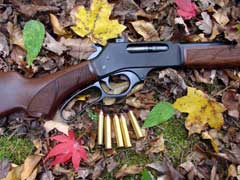
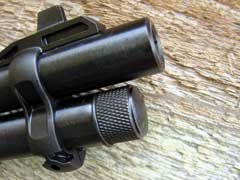
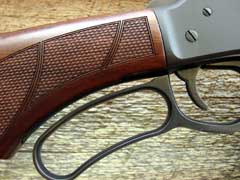
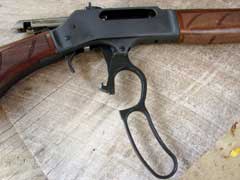
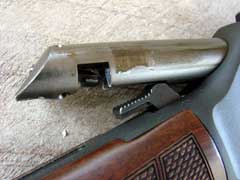
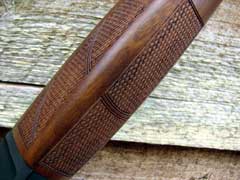
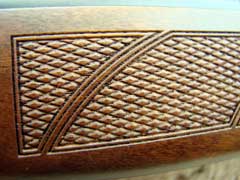
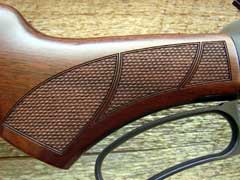
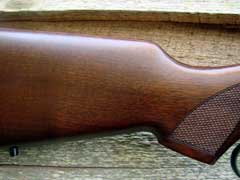
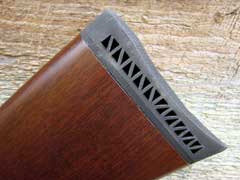
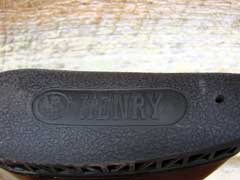
The Henry 45-70 wears a checkered American walnut stock with a soft
synthetic rubber recoil pad.
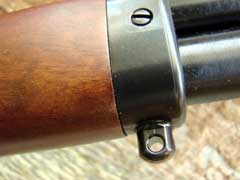
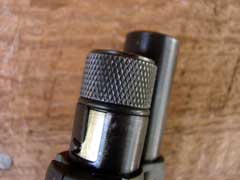
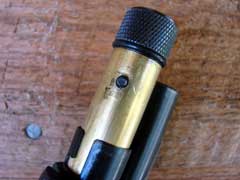
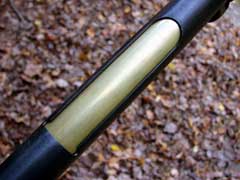
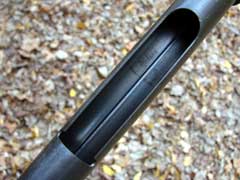
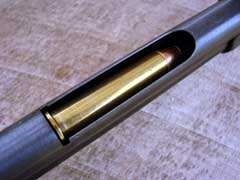
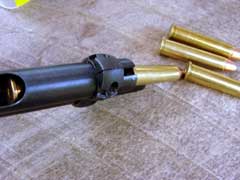
Magazine tube makes loading and unloading the Henry
very simple.
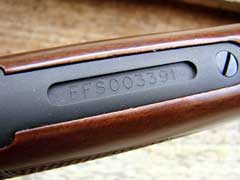
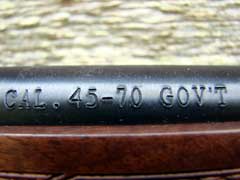
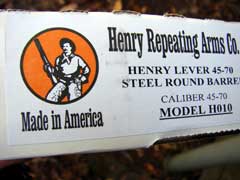
|
|
The lever action rifle is as American as it
gets. Nothing in the firearms industry is as truly American as
is a good lever action. From the deep woods of New England, to
the swamps of the Gulf coast, to the wilderness of Alaska, and
to the great expanses of our Western states, the lever action
has served hunters and shooters for generations, and continues
to do so today. While many hunters have taken to bolt guns and
autoloaders, the lever action continues to do the job in the
hands of hunters and other outdoorsmen who recognize the
reliability and easy-handling that a good levergun delivers.
Personally, I have always loved lever action
rifles. Like many folks my age who grew up watching TV Westerns
as well as Western movies at the show in town, the levergun
instills a feeling of another time in our hearts and minds.
Putting nostalgia aside, if possible, the lever action rifle is
as practical as it is beautiful, and is an efficient and
effective arm for hunting and sport shooting, as well as for
defense from both human and four-legged predators.
Henry Repeating Arms has been in the lever
action rifle business for several years now, making lightweight
and affordable rimfire leverguns, pistol-caliber lever
action rifles, the beautiful Original Henry,
and now this handy and practical 45-70 carbine.
Instead of the brass frame that Henry uses on
most of its other centerfire rifles, the 45-70 has a receiver
made of matte-finished blued steel. The Henry 45-70 is built to
be a hunting/defensive rifle, and for that intended purpose, the
matte black steel frame is a better choice. Also, there are many
commercial 45-70 loads available on the market now, and the
steel Henry is built to contain the higher pressures of such
cartridges. The Henry wears an XS Sights adjustable aperture
rear sight, and combined with the front post, makes for a quick
and efficient sight picture. The XS is rugged and reliable, and
is an excellent choice for such a rifle that might be used for
hunting, as well as bear defense at close range.
Henry lists the magazine capacity of the
45-70 as four, but I had no trouble loading and cycling five
cartridges from the tube. With one chambered, that gives the
owner six powerful cartridges at his disposal, which is more
than most bolt action rifles will carry, and for most shooters,
a lever gun can be cycled much faster than can a bolt gun.
Loading the Henry 45-70 will be familiar to anyone who has
experience loading a tubular magazine on a rimfire rifle, but
might seem odd at first to those accustomed to loading a
centerfire levergun through the side of the receiver. With this
Henry, the inner magazine tube is slid forward, and the
cartridges dropped into the loading port machined into the outer
magazine tube, allowing the cartridges to slide towards the
receiver. When the tube is filled, the inner mag tube is pushed
back into place, and turned clockwise to lock into the outer
tube. This, to me, is as quick if not quicker than stuffing
cartridges through a loading port in the receiver, especially
with long cartridges using heavy blunt-nosed bullets, such as
the 500-grain class of 45-70 ammunition. If the weapon is run
empty and a cartridge needs to be loaded quickly, one can always
toss one into the open ejection port much quicker than stuffing
a cartridge into a loading port in the receiver and then cycling
it into the chamber, so having no loading port in the receiver
is of no consequence to me.
The Henry 45-70 levergun wears an eighteen
and one-half inch (18.43 inches exactly) blued steel barrel. The
magazine stops about three-eights of an inch short of the
barrel, and again, as mentioned above, Henry lists the magazine
capacity at four, but I had no trouble at all loading five
cartridges into the magazine, for a loaded capacity of six.
Thankfully, there is no manual cross-bolt nor tang safety on
this rifle, and none is needed. It also has no traditional
half-cock notch for a safety. Instead, the Henry has a
hammer-mounted transfer bar safety. The hammer does not make
direct contact with the firing pin, but the hammer transfers the
blow through the transfer bar, which rises into position as the
trigger is pressed. The weapon cannot fire from being dropped
onto the hammer, nor can it fire if the hammer slips while
thumb-cocking the hammer. The trigger must be in the rearward
position for the Henry to fire. The trigger releases crisply and
cleanly with just under four pounds of resistance.
The buttstock and forearm are made of
checkered American walnut, and are very well fitted and
finished. The lines of the stock are very tasteful, and the
slight fish-belly of the forearm adds a classic touch. The
pistol grip portion of the stock is very comfortable, and
follows the curvature of the blued-steel lever. Very well done.
The inside of the lever as well as the trigger guard have plenty
of room for a gloved finger. The lever operates the action
easily, and the action is one of the smoothest that I have ever
felt on a new lever action rifle. The Henry is fitted with sling
studs, as should be any hunting rifle.
The Henry 45-70 handles very well. Weighing
in at seven and one-quarter pounds on my scale and measuring
just a hair over thirty-seven inches (37.125 exactly) in length
(Henry lists the OAL at 39 inches), it is quick to the shoulder
and points very naturally.
I fired the Henry 45-70 for accuracy at fifty
yards, using the excellent sights provided. As mentioned above,
the Henry is drilled and tapped for a scope mount, but I love
the way this carbine handles with the XS Sight and front post
combo, so I did the accuracy testing with those. Mounting a
scope does not make a rifle more accurate, but I can fire a
rifle more accurately with a scope attached, and I am positive
that much tighter groups would have been fired with the aid of a
good scope sight. However, I am very satisfied with the
performance of this rifle using the sights provided. Henry could
have saved a few bucks by going with a traditional
barrel-mounted open sight, but the XS Sights were a great
choice, and well worth the premium. The XS is adjustable for
windage and elevation correction, yet is very rugged and
reliable, and also very fast to get on target. Perfect. Group
sizes measured center-to-center varied from well under one inch
to slightly over two inches, but again, the shooter was the weak
point in the accuracy achieved.
Velocities were recorded at a distance of
twelve feet from the muzzle, and are listed in the chart below.
Velocities were recorded at an elevation of 541 feet above sea
level, with an air temperature of seventy-nine degrees and
relative humidity of fifty-five percent. Velocities are listed
in feet-per-second (fps). Bullet weights are listed in grains.
JHP is a jacketed hollowpoint. Barnes X is a homogenous copper
hollowpoint. JFN is a jacketed lead flatnose bullet. Hammerhead
is a hard-cast lead bullet.
| Ammunition |
Bullet Weight |
Velocity |
| Buffalo Bore JFN |
300 |
2263 |
| Buffalo Bore JFN |
405 |
1906 |
| Handload Barnes X |
300 |
1501 |
| Garrett Hammerhead |
420 |
1257 |
| Remington JHP |
300 |
1502 |
Reliability was excellent with every load
tested. The cartridges cycled flawlessly from the magazine into
the chamber, and ejection was smooth and predictable, with the
empty cases falling to the shooter's right, about two feet from
the rifle. There was one failure-to-fire, but the primer had a
perfect imprint from the firing pin, so it was the fault of the
cartridge, and not the rifle. The Henry has the strength to
handle all factory 45-70 ammunition that is made for modern
lever action rifles, such as the premium ammo from Buffalo Bore,
Double Tap, and others. Recoil was easy with most ammunition,
and while brisk using the powerful Buffalo Bore ammo, recoil was
not painful at all. The soft recoil pad and the excellent stock
design of the Henry handled the recoil very well.
The Henry 45-70 carbine exceeded my
expectations, which were high already. The smoothness of the
action, the quality of the wood, and the attention to detail in
the fit and finish, along with the excellent accuracy and easy
handling make the Henry 45-70 rifle an excellent choice as a
hunting rifle or as a handy but powerful rifle for defense in
bear or big cat country.
The Henry 45-70 carbine, as of the date of
this review, has a suggested retail price of $850 US, but doing
some checking around on Gallery
of Guns with gun dealers within fifty miles of my home, I
found the Henry for sale with prices varying from $629 up to
$680, plus sales tax. Like all Henry rifles, the 45-70 is
"Made in America, or not made at all".
Check out the extensive line of American-made
Henry firearms and accessories online at www.henryrifles.com.
For the location of a Henry dealer near you,
click on the DEALER FINDER at www.lipseys.com.
To order the Henry 45-70 carbine online,
Click on the GUN GENIE at www.galleryofguns.com.
To
order quality 45-70 ammunition, go to www.buffalobore.com,
www.midsouthshooterssupply.com,
www.luckygunner.com,
and www.doubletapammo.com.
Jeff Quinn
  
Got something to say about this article?
Want to agree (or disagree) with it? Click the following link to
go to the GUNBlast Feedback Page.
|
|
Click pictures for a larger version.
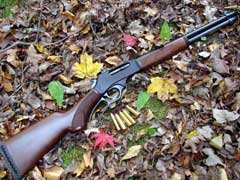
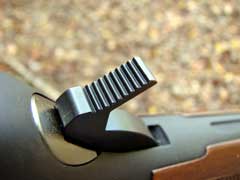
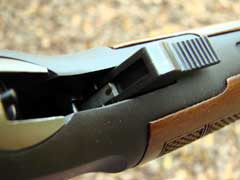
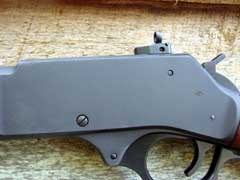
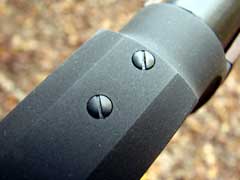
The matte-blued steel receiver is drilled and tapped
for a scope mount.
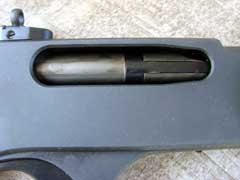
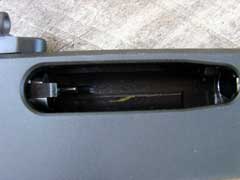
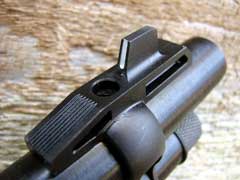
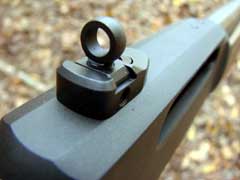
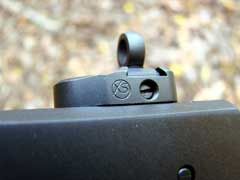
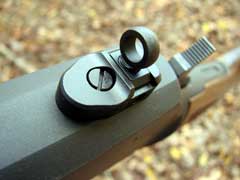
XS Sights adjustable rear aperture and Henry post front
sight.
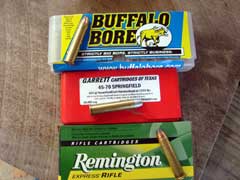
A few of the loads tested in the Henry 45-70 levergun.
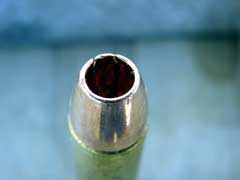
The Barnes 300-grain X bullet is one of the author's
favorites.
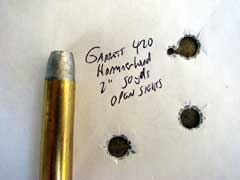
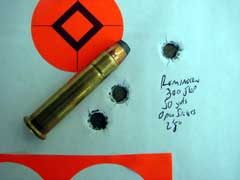
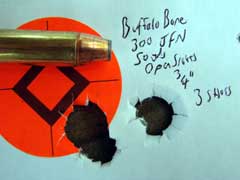
Accuracy at 50 yards, using the aperture / post
combination sights.
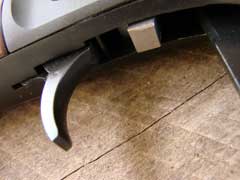
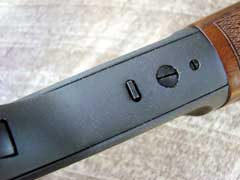
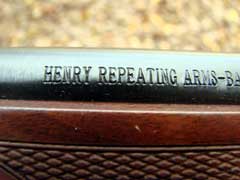
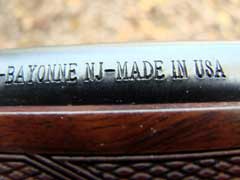
|
![]()